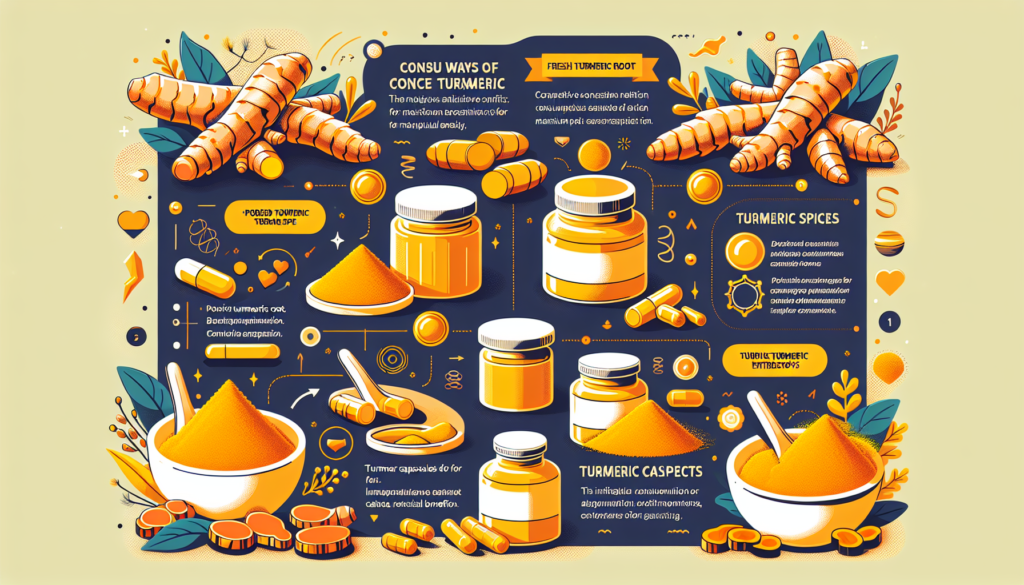So you’ve heard about the amazing benefits of turmeric and now you’re wondering: what is the best way to consume it? Well, look no further because we’re here to guide you through the options. Whether you prefer adding it to your meals, taking it in supplement form, or sipping a warm cup of golden milk, we’ll explore the pros and cons of each method, helping you find the perfect way to incorporate this golden spice into your daily routine. Let’s dive in and discover the best way to consume turmeric for you.

Benefits of Turmeric
Turmeric, a spice commonly used in Indian, Indonesian, and Middle Eastern cuisine, offers a plethora of health benefits. From its anti-inflammatory properties to its potential role in reducing the risk of cancer, turmeric has gained popularity as a superfood. Incorporating turmeric into your diet or skincare routine may provide various advantages for your overall well-being.
Anti-inflammatory properties
One of the key benefits of turmeric is its strong anti-inflammatory properties. The active compound in turmeric, curcumin, has been extensively studied for its ability to reduce inflammation in the body. Chronic inflammation is linked to various health issues, such as heart disease, arthritis, and certain types of cancer. By including turmeric in your daily routine, you may experience a decrease in inflammation and the associated symptoms, such as pain and swelling.
Antioxidant effects
Turmeric also exhibits potent antioxidant effects. Antioxidants are substances that help protect the body from harmful molecules called free radicals, which can cause oxidative stress and contribute to chronic diseases. Curcumin, the main component of turmeric, has been shown to neutralize free radicals and enhance the body’s natural defense mechanisms. By consuming turmeric regularly, you can provide your body with a natural and powerful antioxidant boost.
Boosting brain health
Several studies suggest that turmeric may have beneficial effects on brain health. Curcumin has been found to cross the blood-brain barrier, leading to increased levels of a growth hormone called brain-derived neurotrophic factor (BDNF). BDNF plays a crucial role in the growth and maintenance of brain cells, promoting cognitive function and reducing the risk of brain disorders such as Alzheimer’s disease and depression. Incorporating turmeric into your diet may contribute to better brain health and enhanced cognitive abilities.
Lowering the risk of heart disease
Heart disease is a leading cause of death worldwide, and reducing its risk is a top priority for many individuals. Turmeric may play a role in promoting heart health due to its anti-inflammatory and antioxidant properties. Chronic inflammation and oxidative stress are significant contributors to the development of heart disease. Turmeric’s ability to combat these factors may help lower the risk of heart-related issues, such as high blood pressure and cholesterol levels. Adding turmeric to your meals or beverages can be a simple yet effective way to support cardiovascular health.
Reducing the risk of cancer
Research suggests that turmeric may have potential anti-cancer properties. Curcumin, the active compound in turmeric, has been shown to inhibit the growth of various types of cancer cells, including breast, colon, lung, and prostate cancer cells. Additionally, turmeric may help prevent the formation of new blood vessels in tumors, hindering their growth and spread. While further studies are needed to fully understand the potential benefits of turmeric in cancer prevention and treatment, incorporating this spice into your diet may have a positive impact on your overall well-being.
Understanding Turmeric Consumption
Before exploring the various ways you can consume turmeric, it’s important to understand the different forms in which turmeric is available.
Turmeric powder
Turmeric powder is the most common and easily accessible form of turmeric. It is made by grinding dried turmeric root into a fine powder. This vibrant yellow powder can be used in a wide variety of dishes, including curries, rice, and soups. Turmeric powder is a convenient option for incorporating turmeric into your daily cooking routine.
Fresh turmeric root
Fresh turmeric root, also known as rhizome, is the raw form of turmeric. It resembles ginger in appearance and can be found in the produce section of grocery stores or local markets. Fresh turmeric root can be grated, sliced, or juiced to add a distinct flavor and color to your dishes. While it requires a bit more effort to prepare, fresh turmeric root offers a more intense and earthy taste compared to turmeric powder.
Turmeric supplements
For those who prefer a more concentrated and convenient option, turmeric supplements are available in capsule or tablet form. These supplements typically contain a higher concentration of curcumin, the active compound in turmeric, allowing for a more targeted intake. However, it’s important to choose high-quality supplements from reputable brands to ensure efficacy and safety.
Cooking with Turmeric
Turmeric’s vibrant color and distinctive flavor make it a versatile ingredient in various dishes. Here are some popular ways to incorporate turmeric into your cooking:
Curries and stews
Curries and stews are perhaps the most well-known dishes that feature turmeric. The warm and aromatic flavors of turmeric complement the rich and bold flavors of these dishes. Whether you’re making a traditional Indian curry or experimenting with different cuisines, a teaspoon or two of turmeric powder or grated fresh turmeric root can add a delightful touch to your curries and stews.
Rice and grains
Turmeric can add a pop of color and flavor to plain rice and grains. Simply sprinkle some turmeric powder or add grated fresh turmeric root while cooking to infuse your dishes with a vibrant golden hue. This simple addition not only enhances the visual appeal but also imparts a subtle flavor that pairs well with a variety of dishes.
Soups and broths
If you’re looking to give your soups and broths a boost, turmeric can be your secret ingredient. The earthy and slightly bitter taste of turmeric adds depth to your homemade soups, whether they’re vegetable-based or meat-based. By incorporating turmeric powder or fresh turmeric root into your soup recipes, you can elevate the taste and make them even more nourishing.
Golden Milk
Golden milk, also known as turmeric milk or turmeric latte, is a popular beverage that combines the goodness of turmeric with other flavorful ingredients. Traditionally used in Ayurvedic medicine, Golden Milk offers numerous health benefits and can be a comforting and soothing drink to include in your daily routine.
Ingredients
To make Golden Milk, you will need:
- 1 cup of milk (dairy or plant-based)
- 1 teaspoon of turmeric powder or grated fresh turmeric root
- 1/2 teaspoon of cinnamon
- A pinch of black pepper
- A small piece of ginger (optional)
- Sweetener such as honey or maple syrup (optional)
Preparation
- In a small saucepan, gently heat the milk over medium heat.
- Add turmeric powder or grated fresh turmeric root, cinnamon, black pepper, and ginger (if desired) to the milk.
- Stir well to combine the ingredients.
- Allow the milk to simmer for 5-10 minutes, ensuring it does not boil.
- If desired, add sweetener to taste and stir until dissolved.
- Strain the Golden Milk into a cup and serve warm.
Benefits
Golden Milk offers a multitude of benefits due to the combination of turmeric and other ingredients. Consuming Golden Milk may help reduce inflammation, support digestive health, promote better sleep, boost immune function, and provide relaxation and comfort. This delicious and nourishing beverage can be enjoyed as a soothing bedtime treat or during any time of the day for a warm and comforting experience.

Turmeric Tea
Another popular way to consume turmeric is in the form of a soothing and aromatic tea. Turmeric tea allows you to enjoy the benefits of turmeric in a simple and refreshing manner.
Ingredients
To make Turmeric Tea, you will need:
- 1 teaspoon of turmeric powder or grated fresh turmeric root
- 1 cup of water
- A slice of lemon or a teaspoon of honey (optional)
Preparation
- Bring the water to a boil in a small saucepan.
- Add turmeric powder or grated fresh turmeric root to the boiling water.
- Reduce heat and let the tea simmer for 10-15 minutes.
- Remove from heat and strain the tea into a cup.
- Add a slice of lemon or a teaspoon of honey for added flavor, if desired.
Benefits
Turmeric tea provides a soothing and warming sensation, making it a perfect beverage for relaxation and wellness. Like Golden Milk, turmeric tea offers anti-inflammatory and antioxidant properties, promoting overall health and well-being. It can be enjoyed as a daily ritual or during times when you desire a moment of tranquility and self-care.
Turmeric Smoothies
For those who prefer a quick and easy way to incorporate turmeric into their diet, turmeric smoothies are a delicious and nutritious option. Packed with vitamins, minerals, and antioxidants, turmeric smoothies make for a vibrant and energizing treat.
Ingredients
To make a Turmeric Smoothie, you will need:
- 1 cup of frozen fruits (such as berries, banana, or mango)
- 1 tablespoon of turmeric powder or grated fresh turmeric root
- 1 cup of milk (dairy or plant-based)
- 1 tablespoon of honey or maple syrup (optional)
- A handful of spinach or kale (optional, for added nutrients)
Preparation
- Place all the ingredients in a blender.
- Blend on high speed until smooth and creamy.
- Taste and adjust the sweetness with honey or maple syrup, if desired.
- Pour the smoothie into a glass and enjoy immediately.
Benefits
Turmeric smoothies provide a delicious and convenient way to nourish your body with the benefits of turmeric. Packed with antioxidants, fiber, and essential nutrients from fruits and vegetables, turmeric smoothies can boost your energy, support immune function, and promote overall health. Whether as a quick breakfast option or a refreshing afternoon snack, turmeric smoothies can be a tasty addition to your daily routine.

Topical Application
In addition to consuming turmeric internally, topical application can provide specific benefits for your skin. Turmeric can be used in various ways to create homemade skincare products that can improve your complexion and promote healthy skin.
Turmeric paste
A simple way to utilize turmeric for skincare is by creating a turmeric paste. Turmeric paste can be applied directly to the skin or used as a base for various face masks and body scrubs.
To make a basic turmeric paste, you will need:
- 1/2 cup of turmeric powder
- 1/2 cup of water
Mix the turmeric powder and water in a bowl until you achieve a thick, paste-like consistency. Apply the turmeric paste onto the desired areas of your skin and leave it on for 10-15 minutes. Rinse off with warm water and pat dry. Turmeric paste may help reduce skin inflammation, promote a healthy glow, and address common skin concerns such as acne and dark spots.
Face masks
Turmeric can be combined with other natural ingredients to create homemade face masks tailored to specific skin needs. Here are a few examples:
- Turmeric and honey face mask: Mix 1 tablespoon of turmeric powder with 1 tablespoon of raw honey. Apply the mask to your face and let it sit for 15-20 minutes before rinsing off. This mask may help soothe and moisturize the skin while providing a brightening effect.
- Turmeric and yogurt face mask: Combine 1 tablespoon of turmeric powder with 2 tablespoons of plain yogurt. Apply the mask to your face and leave it on for 15-20 minutes. Rinse off with lukewarm water. This mask can help improve skin texture, reduce blemishes, and provide a natural glow.
Always perform a patch test before applying any homemade face mask to ensure you don’t have any adverse reactions to the ingredients.
Body scrubs
Turmeric can also be incorporated into body scrubs to exfoliate and revitalize the skin. Here’s a simple recipe for a turmeric body scrub:
- 1/2 cup of turmeric powder
- 1/2 cup of granulated sugar or sea salt
- 1/4 cup of coconut oil or olive oil
Mix all the ingredients in a bowl until well combined. Gently massage the scrub onto damp skin in circular motions, focusing on rough areas such as elbows and knees. Rinse off with warm water and pat dry. This turmeric body scrub can help remove dead skin cells, improve circulation, and leave your skin feeling smooth and refreshed.
Combining Turmeric with Black Pepper
To enhance the absorption of curcumin, the active compound in turmeric, it is often recommended to consume turmeric with black pepper. Black pepper contains a compound called piperine, which has been shown to improve the bioavailability of curcumin in the body.
Enhancing turmeric absorption
When combined with piperine, curcumin absorption can be significantly increased. The piperine in black pepper inhibits certain enzymes that break down curcumin, allowing it to remain in the body for longer periods. This, in turn, enhances the therapeutic effects of turmeric consumption.
Simple recipes to try
Combining turmeric and black pepper can be as simple as adding a dash of black pepper to your turmeric-infused dishes or beverages. Here are a few examples:
- Turmeric and black pepper roasted vegetables: Toss your favorite vegetables in olive oil, turmeric powder, and a pinch of black pepper. Roast in the oven until golden and tender. This flavorful side dish provides a nutritional boost while ensuring optimal turmeric absorption.
- Turmeric and black pepper salad dressing: Whisk together olive oil, lemon juice, turmeric powder, a pinch of black pepper, and your choice of herbs and spices to create a vibrant salad dressing. Drizzle over fresh greens for a zesty and nutritious salad.
By incorporating black pepper into your turmeric-rich recipes, you can maximize the benefits of turmeric and promote optimal absorption of its active compounds.

Additional Tips
While turmeric offers numerous health benefits, it is essential to keep a few additional tips in mind to make the most of its consumption:
Consulting with a healthcare professional
If you have any existing health conditions or are taking medications, it is advisable to consult with a healthcare professional before incorporating turmeric into your diet or skincare routine. They can provide personalized guidance and ensure turmeric is safe and suitable for your individual circumstances.
Avoiding excessive consumption
While turmeric is generally safe when consumed in moderate amounts as part of a balanced diet, excessive consumption may lead to certain risks. Very high doses of turmeric or long-term use of turmeric supplements may cause gastrointestinal issues, such as stomach upset or diarrhea. It is important to adhere to recommended dosage guidelines and listen to your body’s response when consuming turmeric.
Purchasing high-quality turmeric products
To reap the maximum benefits of turmeric, it is crucial to choose high-quality products. Look for organic turmeric powder or fresh turmeric root from reputable suppliers. When opting for turmeric supplements, select trusted brands that use standardized extracts and adhere to strict quality control measures.
Conclusion
Incorporating turmeric into your diet and skincare routine can provide a wide range of benefits. From its anti-inflammatory and antioxidant properties to its potential in supporting brain health and reducing the risk of chronic diseases, turmeric has earned its status as a superfood. Whether you prefer cooking with turmeric, enjoying a warm cup of Golden Milk or Turmeric Tea, or creating homemade skincare products, the options for incorporating turmeric into your daily routine are plentiful. Remember to consult with a healthcare professional, avoid excessive consumption, and choose high-quality turmeric products for optimal results. Embrace the golden goodness of turmeric and embrace a healthier, more vibrant lifestyle.

